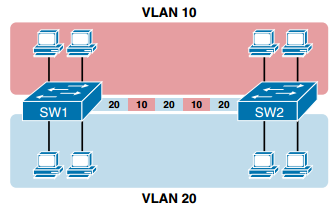CCNA DC FAQ: VLAN and Trunking Concepts
 Figure: Multiswitch VLAN with Trunking
Figure: Multiswitch VLAN with Trunking
Q1. In a LAN, which of the following terms best equates to the term VLAN?
a. Collision domain
b. Broadcast domain
c. Subnet
d. Single switch
e. Trunk
B. A VLAN is a set of devices in the same Layer 2 broadcast domain. A subnet often includes the exact same set of devices, but it is a Layer 3 concept. A collision domain refers to a set of Ethernet devices, but with different rules than VLAN rules for determining which devices are in the same collision domain.
Q2. Imagine a switch with three configured VLANs. How many IP subnets are required, assuming that all hosts in all VLANs want to use TCP/IP?
a. 0.
b. 1.
c. 2.
d. 3.
e. You can’t tell from the information provided.
D. Although a subnet and a VLAN are not equivalent concepts, the devices in one VLAN are typically in the same IP subnet and vice versa.
Q3. Switch SW1 sends a frame to switch SW2 using 802.1Q trunking. Which of the answers describes how SW1 changes or adds to the Ethernet frame before forwarding the frame to SW2?
a. It inserts a 4-byte header and changes the MAC addresses.
b. It inserts a 4-byte header and does not change the MAC addresses.
c. It encapsulates the original frame behind an entirely new Ethernet header
d. None of the other answers is correct.
B. 802.1Q defines a 4-byte header, inserted after the original frame’s destination and source MAC address fields. The insertion of this header does not change the original frame’s source or destination address. The header itself holds a 12-bit VLAN ID field, which identifies the VLAN associated with the frame.
Q4. For an 802.1Q trunk between two Ethernet switches, which answer most accurately defines which frames do not include an 802.1Q header?
a. Frames in the native VLAN (only one)
b. Frames in extended VLANs
c. Frames in VLAN 1 (not configurable)
d. Frames in all native VLANs (multiple allowed)
A. 802.1Q defines the native VLAN as one designated VLAN on a trunk for which the devices choose to not add an 802.1Q header for frames in that VLAN. The switches can set the native VLAN to any VLAN ID, but the switches should agree. The default native VLAN is VLAN 1. Note that only one such native VLAN is allowed on any one trunk; otherwise, that VLAN associated with untagged frames could not be discerned by the receiving switch.
Q5. A Nexus switch has some ports assigned to VLAN 11 and some to VLAN 12. Which of the following devices, acting as described in the answers, can forward data between ports in different VLANs? (Choose two answers.)
a. The Nexus switch when acting as a Layer 2 switch
b. The Nexus switch when acting as a Layer 3 switch
c. An external router
d. An external bridge
B and C. Each VLAN, a Layer 2 concept, is its own broadcast domain. A Layer 2 switch purposefully keeps broadcast domains separate, purposefully choosing to not forward traffic that enters in a port in one broadcast domain (VLAN) into a second broadcast domain (VLAN). Bridges use the same forwarding logic as a Layer 2 switch. Devices that perform IP routing, like routers and switches configured as Layer 3 switches, can route IP packets between the devices in different VLANs.
Q6. A network engineer wants to use VTP to distribute VLAN configuration information to all switches in a data center so that all switches learn a new VLAN configuration when a VLAN configuration change is made. Which of the following modes cannot be used on any of the switches? (Choose two answers.)
a. Server
b. Off
c. Transparent
d. Client
B and C. Only VTP server and client modes allow a switch to learn new information with VTP. Transparent and off modes give switches a couple of ways to effectively not use VTP; switches using both these modes will not update their configuration based on receiving a VTP message.
Q7. Which of the following answers list configuration information that VTP distributes? (Choose two answers.)
a. VLAN name
b. VLAN assigned to a switch port
c. Ports on which 802.1Q is enabled
d. VLAN ID
D. Of the listed answers, VTP distributes only the VLAN ID and VLAN name. VTP does not distribute configuration that ties to specific ports on any one switch.